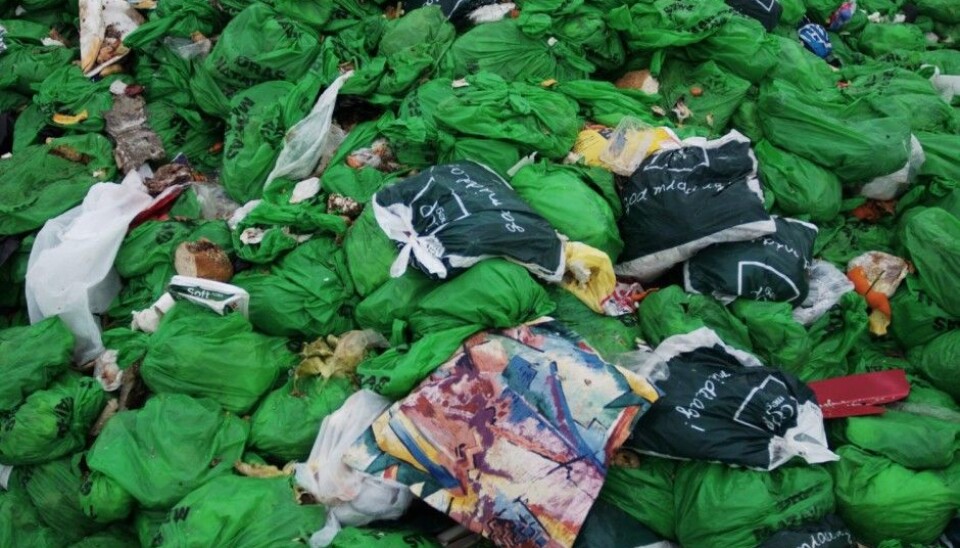
Most food waste from households
Large amounts of food go to waste. Some is disposed of by producers and retailers. But more is tossed out at the consumption stage – by the likes of you and me.
Contrary to popular belief, the food industry and grocery stores are not the biggest squanderers of food.
We consumers are the worst bad guys.
We are the source of two-thirds of total food wastage.
Østfold Research Co. in Fredrikstad monitors food wastage in Norway and its latest annual summary show the distribution of what could be designated as our sorrowful extravagance:

- 60,000 tonnes of food are thrown out by the food industry
- 68,000 tonnes of food are thrown out by retailers
- 231,000 tonnes of food are thrown out by households
Mainly bread, vegetables and fruit
Let’s look at the retailers first.
When asked by the researchers, grocers say that 90 percent of their food waste consists of products that have outlived their shelf-lives.
The latest figures from the research project ForMat, led by Østfold Research Co., show that 2.7 percent of the food taken in for sale by retailers ends up being thrown away.
Key items are bread and bakery goods, fruit and vegetables, fresh ready-to-serve deli foods and fresh seafood.
Supermarkets now throw out relatively little milk products, eggs, cheese, frozen foods and dry goods.
Many of us reach to the back of refrigerated shelves and freezers hunting for items with the best possible dates. If we consumers select items that are approaching their shelf lives or have already passed the printed overdue date, we can contribute to reducing the wastage from our supermarkets.
Stores make progress
In the latest study by Østfold Research, producers and retailers reportedly confirm their keen interest in reducing wastage.
The good news is that they appear to be succeeding.
It should be noted that Norway is probably the Nordic country which allows for the longest “best before” dates of perishable foods.
The researchers compared the shelf-lives of comparable products in the different Nordic countries and found them surprisingly different.
Plan your purchases
“The decidedly largest potential for curbing food wastage is to change habits in households,” asserts Professor Ole Jørgen Hanssen at Østfold Research.
But the reduction in food wastage in our homes is not simply a case of eating food that has passed its “Best before” date.
The main problem is that many of us need to revise the way we plan our meals and purchases.
“Check your cupboards and refrigerator before going to the store. Find out what you need. Make out a grocery list,” urges Ole Jørgen Hanssen.
“Best before” is not a terminal date
In recent years, several food producers have changed the way they mark shelf lives of their products. For food that can take it, they no longer write “Last day of consumption”.
They use the more elastic phrase “Best before”.
So by no means is it imperative to throw out food that has surpassed this date. These eggs or this cream are not necessarily spoiled. It just means that the producer cannot guarantee the consumer that the product will be fully as good as it originally was.
But in general it is just fine.
The producers leave the matter up to the individual consumer and his or her taste buds. We can generally taste, smell or see when food is off.
If you have food that is past its “Best before” date and is spoiled, you will almost surely notice that it looks bad, smells wrong or tastes stale or rotten long before you start spooning it in.
Of course the date provided on the packaging does not always apply once the product has been opened. Foods usually need to kept wrapped and air tight and perhaps cool.
We throw out less than we used to
The Østfold Research group found that when you and I throw food in the garbage the most common justification we give is that it has surpassed its shelf-life. If more consumers trusted their own senses much of this food could be eaten.
At least we waste a little less food than we used to.
The team at Østfold Research Co. see signs that we have grown better at assessing food perishability on our own.
The researchers also found that fewer people at least claim to be making too much food and throwing out the leftovers.
Apparently, more of us are also getting better at taking helpings on our plates that we can manage. Our eyes are less likely to be bigger than our stomachs.
-------------------------------------
Read the Norwegian version of this article at forskning.no
Translated by: Glenn Ostling
Scientific links
External links
- Ole Jørgen Hanssen's profile
- Matsvinn.no – Website for the research project “For Mat”
- Matvett.no – The food industry’s website on preventing waste

































